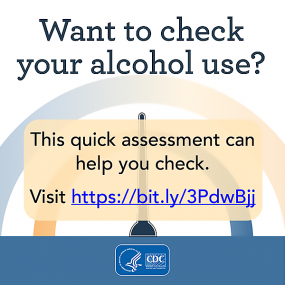Excessive Alcohol Use is a Risk to Women’s Health
Excessive alcohol use is associated with nearly 59,000 deaths among women.1 Excessive alcohol use poses unique health and safety risks to females.2
Alcohol Use is Common Among Women and Girls

- Nearly half of adult women report drinking alcohol in the past 30 days.3
- Approximately 13% of adult women report binge drinking. Among them, 25% do so at least weekly, on average, and 25% consume at least six drinks during a binge drinking occasion.3
- Almost 18% of women of child-bearing age (i.e., ages 18–44 years) binge drink.3
- In 2019, about 32% of female high school students consumed alcohol compared with 26% of male high school students. Binge drinking was also more common among female (15%) than male (13%) high school students.4
- In 2020, 9% of women overall and 17% of women aged 18 to 25 years had an alcohol use disorder.5
Alcohol Affects Women Differently than Men
Although men are more likely to drink alcohol and consume larger amounts, biological differences in body structure and chemistry lead most women to absorb more alcohol and take longer to metabolize it. After drinking the same amount of alcohol, women tend to have higher blood alcohol levels than men, and the immediate effects of alcohol usually occur more quickly and last longer in women than men. These differences make women more susceptible to the long-term negative health effects of alcohol compared with men.2
Alcohol is Associated with other Diseases, Injuries, and Harms
- Liver Disease: The risk of cirrhosis and other alcohol-related liver diseases is higher for women than for men.2,6
- Impact on the Brain: Alcohol-related cognitive decline and shrinkage of the brain develop more quickly for women than for men.2
- Impact on the Heart: Women who drink excessively are at increased risk for damage to the heart muscle at lower levels of consumption and over fewer years of drinking than men.2
- Breast and other Cancers: Alcohol consumption increases the risk of cancers of the mouth, throat, esophagus, liver, and colon. In women, drinking is also associated with breast cancer, even at low levels of consumption.2,7
- Sexual Violence: Excessive alcohol use, particularly binge drinking, is a major contributing factor to sexual violence.8,9 Changes in alcohol-related policies can reduce sexual violence in communities.10
There is No Known Safe Amount of Alcohol Use during Pregnancy
- In a recent study, 10% of respondents who were pregnant drank alcohol and 4.5% binge drank.14
- Alcohol use during pregnancy increases the risk of having a baby with fetal alcohol spectrum disorders (FASD). The most severe form is fetal alcohol syndrome (FAS), which is associated with intellectual disabilities and birth defects.15
- FASD are 100% preventable if a person does not drink while pregnant or while trying to become pregnant. It is not safe to drink at any time during pregnancy.16
- Excessive alcohol use increases the risk of miscarriage, stillbirth, premature delivery and Sudden Infant Death Syndrome (SIDS).2,17,18
Women can reduce the amount of alcohol they drink to reduce their risk of harms.
The Alcohol Use and Your Health Fact Sheet addresses a number of additional health conditions associated with excessive alcohol use that affect both men and women.
- Centers for Disease Control and Prevention. Alcohol-Related Disease Impact Application website. Accessed February 29, 2024.
- Erol A, Karpyak VM. Sex and gender-related differences in alcohol use and its consequences: Contemporary knowledge and future research considerations. Drug Alcohol Depend 2015;156:1–13.
- Centers for Disease Control and Prevention. Behavioral Risk Factor Surveillance System.
- Jones CM, Clayton HB, Deputy NP, et al. Prescription opioid misuse and use of alcohol and other substances among high school students — Youth Risk Behavior Survey, United States, 2019. MMWR Suppl 2020;69:38–46.
- Substance Abuse and Mental Health Services Administration. Results from the 2020 National Survey on Drug Use and Health: Detailed Tables. Rockville, MD: 2021.
- Roerecke M, Vafaei A, Hasan OSM, et al. Alcohol consumption and risk of liver cirrhosis: A systematic review and meta-analysis. Am J Gastroenterol 2019;114:1574–1586.
- Rehm J, Shield KD, Weiderpass E. Alcohol Consumption: A Leading Risk Factor for Cancer. In: Wild CP, Weiderpass E, Stewart BW, eds. World Cancer Report. Lyon, France: International Agency for Research on Cancer; 2020:68–76.
- Centers for Disease Control and Prevention. Sexual Violence: Risk and Protective Factors website. Accessed October 31, 2022.
- Mohler-Kuo M, Dowdall GW, Koss M, Wechsler H. Correlates of rape while intoxicated in a national sample of college women. Journal of Studies on Alcohol 2004;65:37–45.
- Basile KC, DeGue S, Jones K, et al. STOP SV: A Technical Package to Prevent Sexual Violence. Atlanta, GA: CDC; 2017.
- Rachdaoui N, Sarkar DK. Pathophysiology of the effects of alcohol abuse on the endocrine system. Alcohol Res 2017;38:255–276.
- Naimi TS, Lipscomb LE, Brewer RD, Gilbert BC. Binge drinking in the preconception period and the risk of unintended pregnancy: Implications for women and their children. Pediatrics 2003;111(5):1136–1141.
- Centers for Disease Control and Prevention. Staying Healthy and Preventing STDs website. Accessed October 31, 2022.
- England LJ, Bennett C, Denny CH, Honein MA, Gilboa SM, Kim SY, Guy GP, Tran EL, Rose CE, Bohm MK, Boyle CA. Alcohol use and co-use of other substances among pregnant females aged 12–44 years — United States, 2015–2018. MMWR 2020;69:1009–1014.
- Mattson SN, Bernes GA, Doyle LR. Fetal alcohol spectrum disorders: a review of the neurobehavioral deficits associated with prenatal alcohol exposure. Alcohol Clin Exp Res 2019;43:1046–62.
- Centers for Disease Control and Prevention. Fetal Alcohol Spectrum Disorders (FASDs) website. Accessed October 30, 2022.
- Bailey BA, Sokol RJ. Prenatal alcohol exposure and miscarriage, stillbirth, preterm delivery, and sudden infant death syndrome. Alcohol Res Health 2011;34:86–91.
- Moon RY; Task Force on Sudden Infant Death Syndrome. SIDS and other sleep-related infant deaths: Evidence base for 2016 updated recommendations for a safe infant sleeping environment. Pediatrics 2016;138:e2016–2940.
